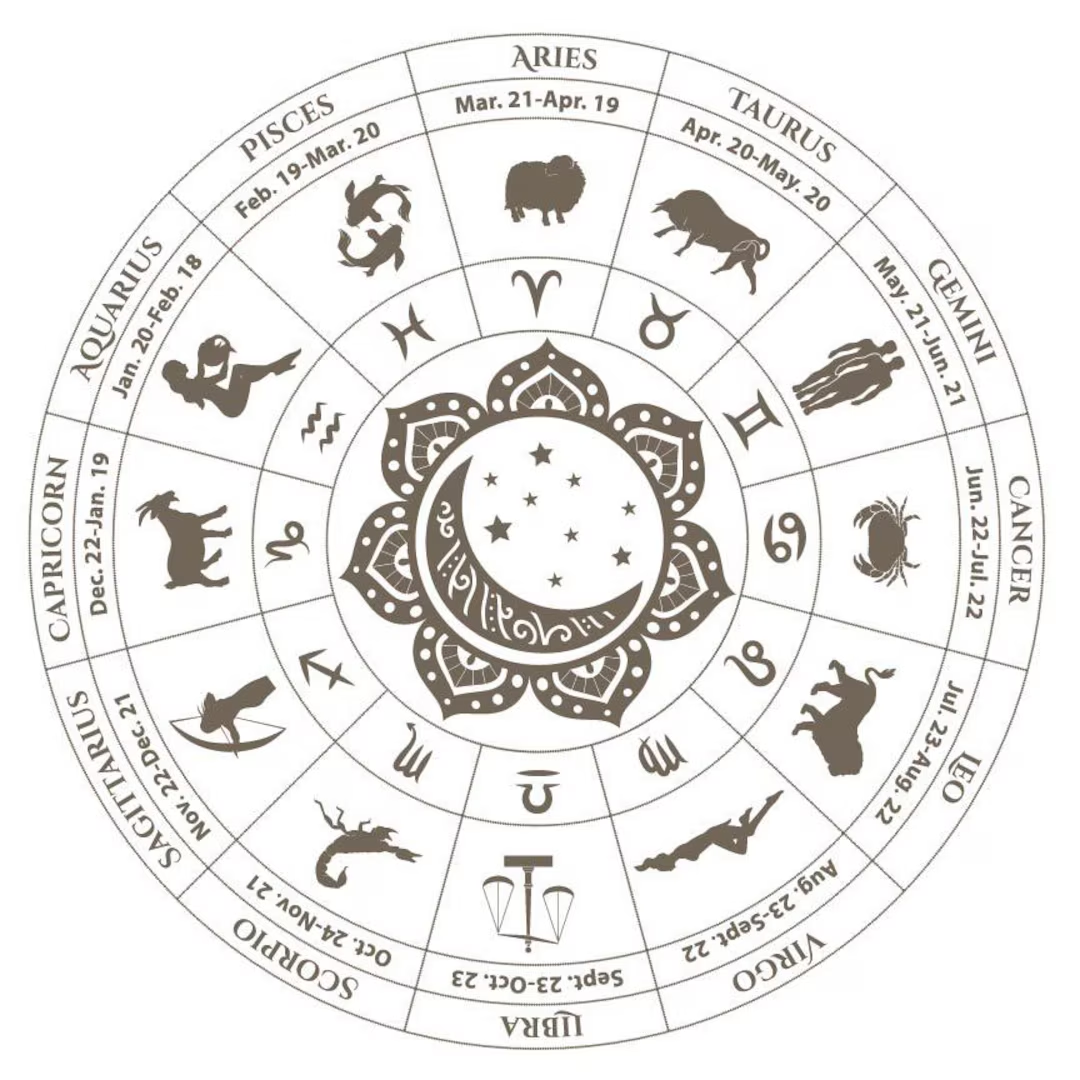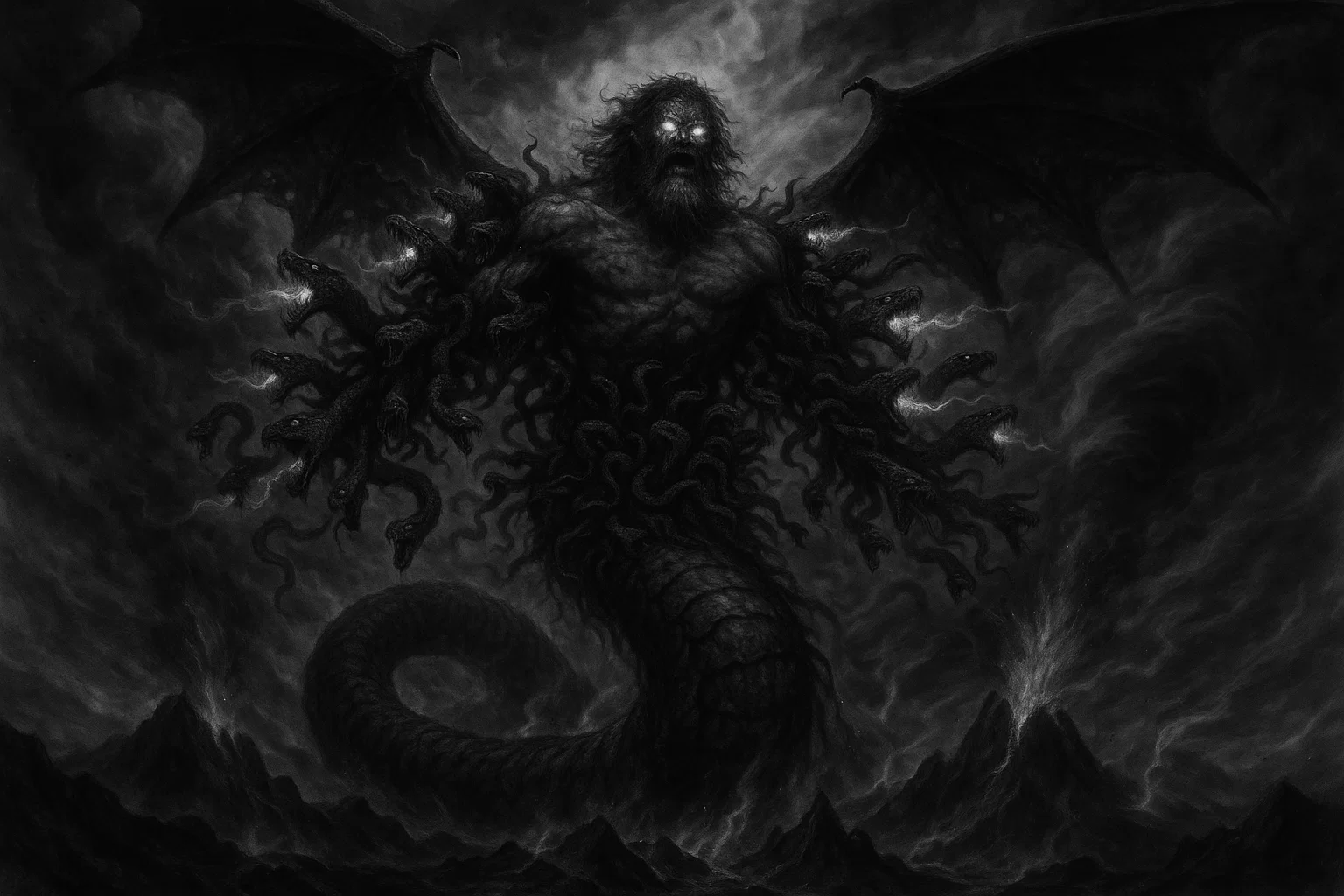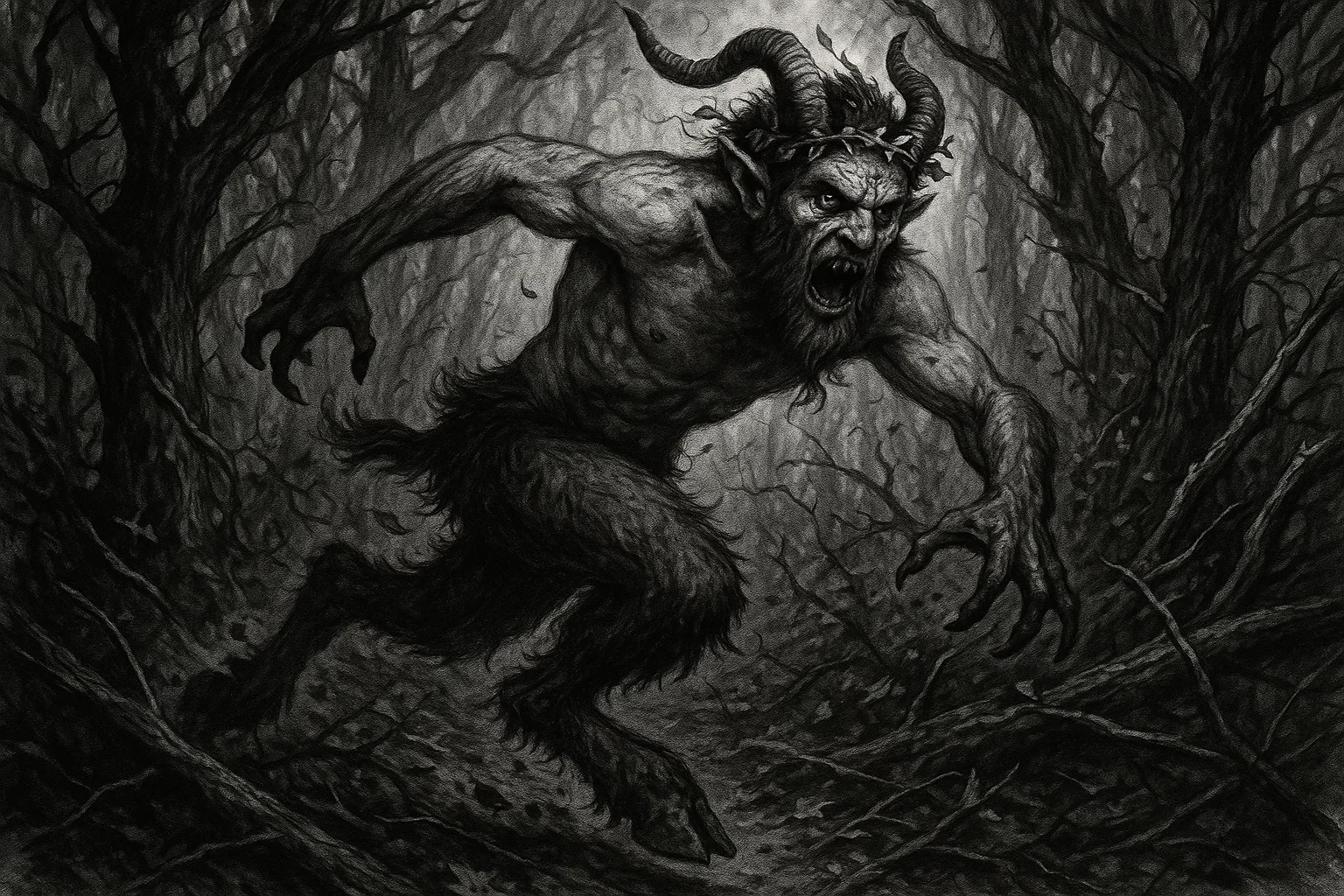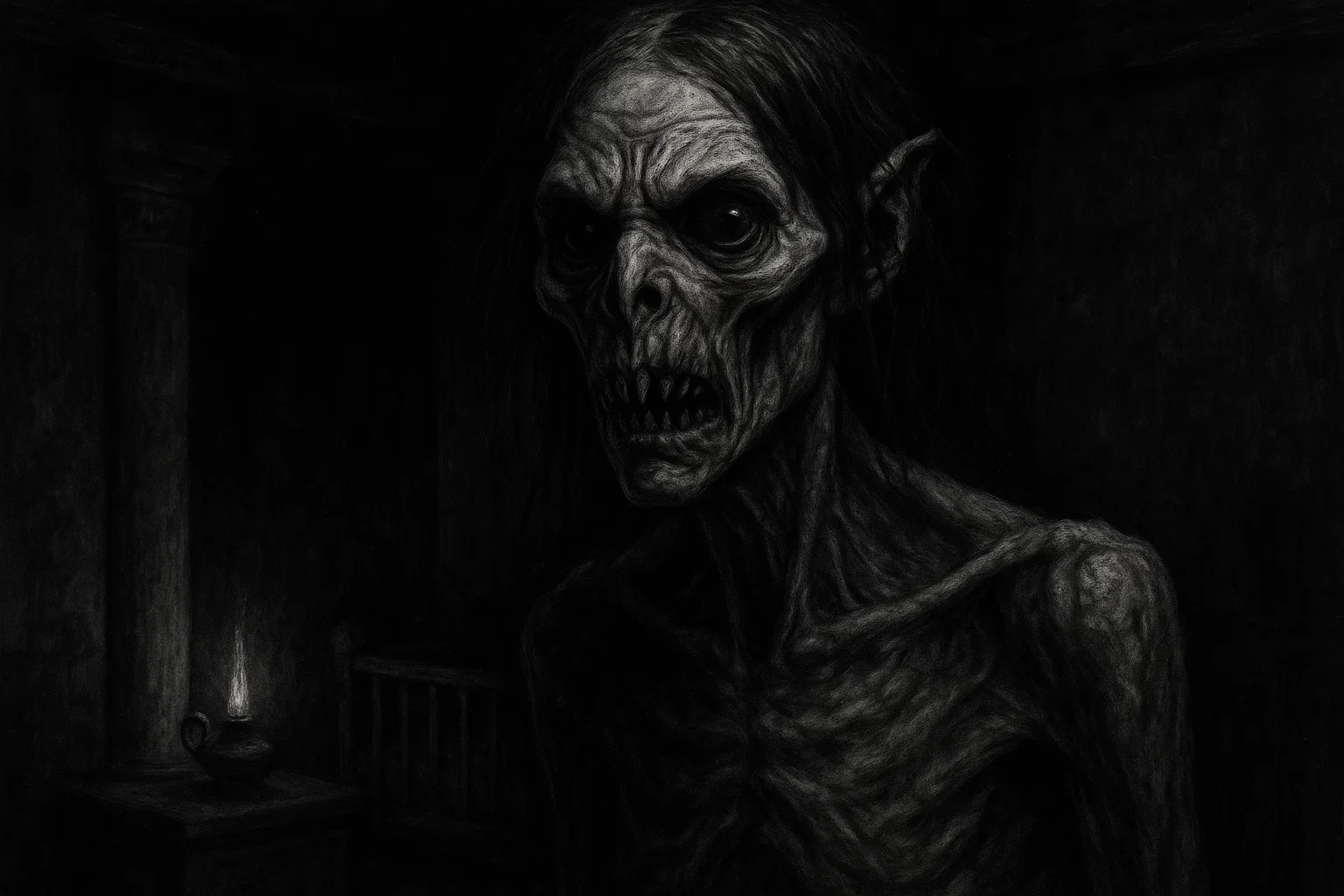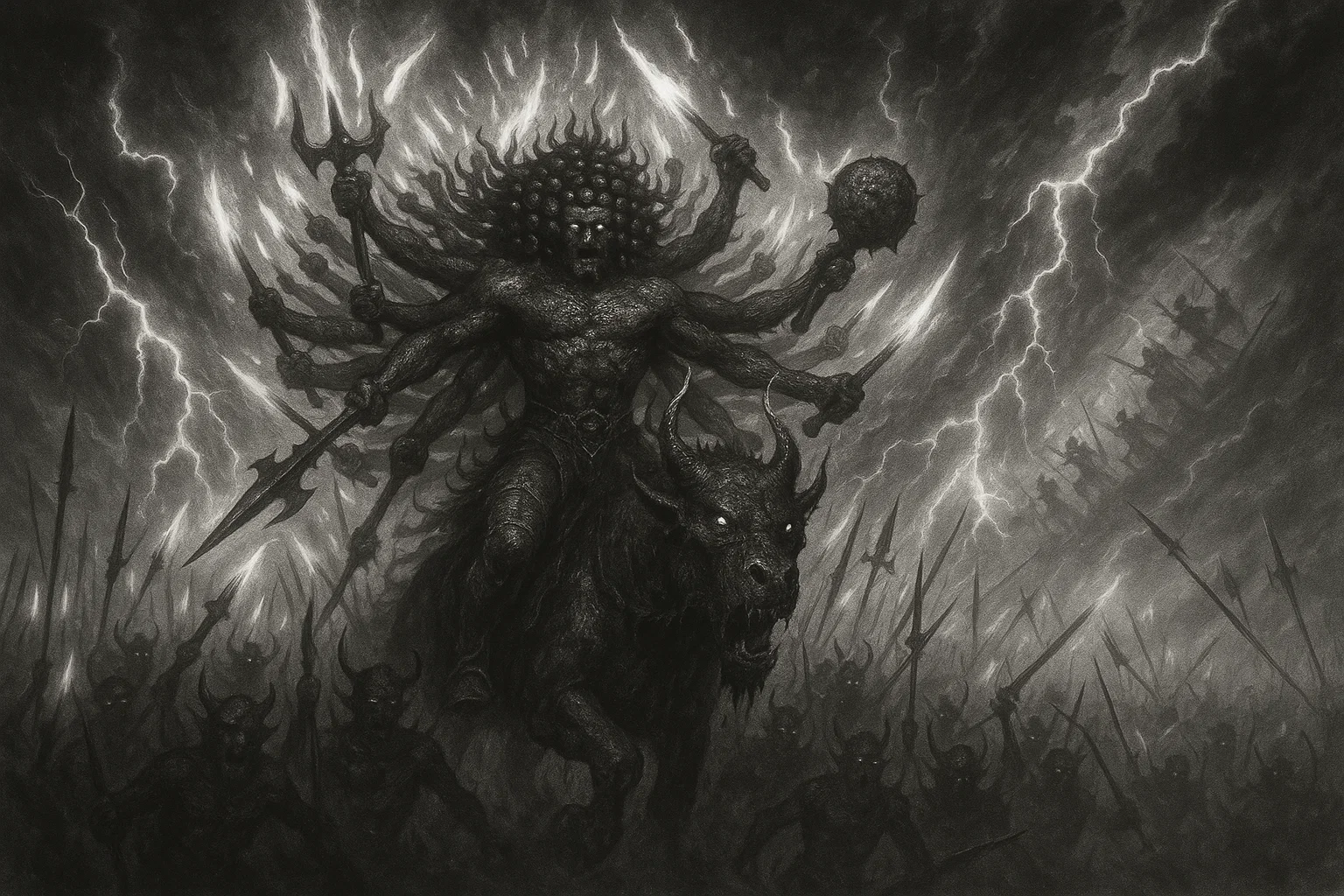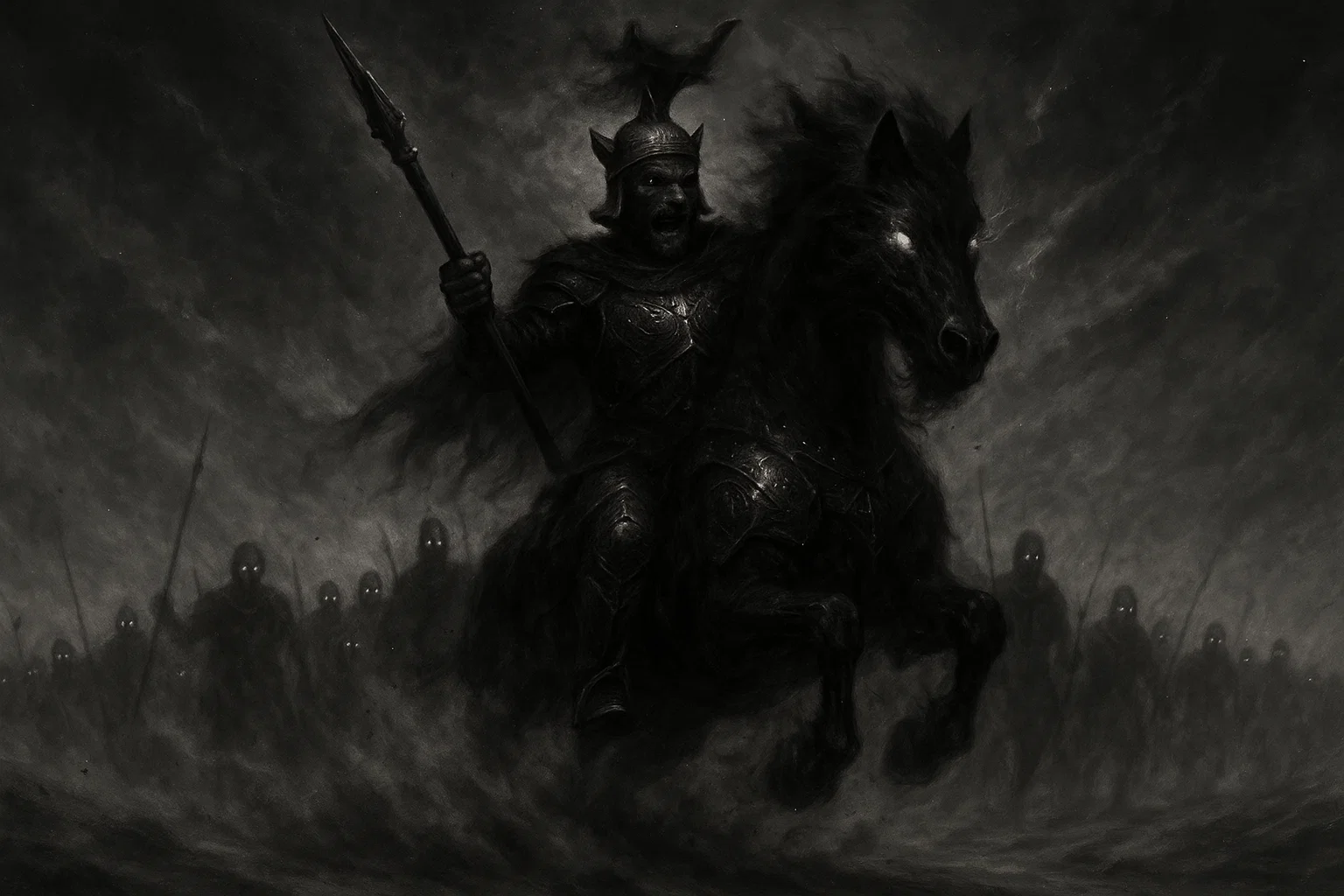Lamia is a demonic entity from ancient Greek mythology. According to stories, she was transformed from a beautiful queen of Libya to a terrifying snake-like monster.
She is defined by her insatiable hunger for children, driven by divine vengeance and sorrow. She is primarily depicted as a child-murdering demon and a type of vampire, often associated with darkness and night.
Her story embodies themes of divine jealousy, tragic transformation, and monstrous maternal despair.
Summary
Key Takeaways
| Attribute | Details |
| Name | Lamia, Lamie, Lamian Queen, Lamian Witches, Empusa (sometimes conflated) |
| Title | Child-Devourer, Serpent Queen, Night-Hag |
| Gender | Female |
| Origin | Originally a beautiful queen of Libya, daughter of King Belus and Queen Lybie. Transformed into a monster by the goddess Hera after her children with Zeus were killed. |
| Appearance | Varies greatly; often described as a serpentine or dragon-like creature from the waist down, with the torso and head of a woman; sometimes depicted as a beautiful woman who can remove her eyes. |
| Hierarchy | Not formally part of a rigid infernal hierarchy like Christian demonology; functions as a powerful supernatural monster or spirit in Greek folklore. |
| Superior Demon | Not applicable in the primary Greek myths; her tormentor is the Olympian goddess, Hera. |
| Servitors | Sometimes associated with a class of Lamiae or Lamian spirits; occasionally conflated with the Empusae. |
| Associated Figures | Zeus (her lover), Hera (her enemy and tormentor), Scylla (sometimes considered her daughter). |
| Powers | Inflicting insomnia; the ability to remove and reinsert her own eyes; child-devouring (pedophagy); seducing men to drink their blood/flesh (vampiric traits); shapeshifting (from monster to beautiful woman). |
| Weaknesses | Eyesight (when removed, she is blind); light/daylight (sometimes); powerful protective magic and possibly the name of Hera. |
| Opposing Angel/Saint | Not applicable; counteracted by Apotropaic magic and protective deities/heroes in Greek tradition. |
| Equipment/Tools | Her removable eyes, granted by Zeus, which allow her to rest. |
| Pantheon | Ancient Greek Mythology and Folklore |
| Notable Myths | Her transformation and the killing of her children by Hera; her appearance in later Roman and Medieval folklore as a succubus or witch. |
Etymology
The name Lamia derives from the Ancient Greek Λαμ iˊα (Lamía), which is generally understood to mean “gorge” or “gullet,” suggesting an association with the consumption of food, particularly the children she devours.
The term is sometimes linked to λαμ oˊς (lāmos), meaning “throat” or “gullet,” or λαμ uˊρος (lamyrós), meaning “gluttonous.” This etymological connection strongly focuses on her primary monstrous trait: voracious consumption, specifically of human flesh, linking her name directly to her predatory nature.
In classical antiquity, the term Lamia was also used more generally as a noun to describe a type of man-eating monster or bogeyman used to frighten children. This suggests that the proper name of the Libyan Queen evolved into a generic term for a monstrous female predator.
Later, in Roman, Byzantine, and Medieval traditions, the term Lamia became conflated with other nocturnal female spirits and vampires, such as the striges or succubi, often retaining the core meaning of a blood-drinking, child-stealing supernatural being.
The development of the name thus tracks the figure’s evolution from a specific mythological queen to a broader archetype of the vampiric night-demon.
Your Personalized, Hyper Accurate Moon & Astrology Reading
Limited time offer: Get your FREE, fully personalized Moon & Astrology Reading that takes astrology to a whole new level. Discover the secret depths of your personality, relationships, and true purpose in life.
What does the Demon Lamia Looks Like?
The physical description of Lamia is inconsistent and shifts dramatically across the mythological and folkloric record, reflecting her transformation from a human queen to a monster. Her original form was that of a woman of great beauty.
Following her transformation, she is most commonly depicted in classical Greek sources, such as Diodorus Siculus, as grotesque and frightening.
She is frequently depicted as a hybrid creature, with a woman’s upper body and face but a serpent’s or dragon’s lower extremities. This snake-like tail focuses on her monstrous, non-human nature and her association with the earth and chthonic elements.
In some descriptions, her face is said to be hideously distorted by her grief and rage, and her body is sometimes described as having a monstrous, dragon-like bulk.
A unique and significant physical trait granted by Zeus was the ability to remove and reinsert her eyes. When Hera killed her children, she cursed Lamia to never be able to close her eyes, thus forcing her to perpetually witness the image of her dead children.
Zeus, pitying her, gave her this detachable feature, allowing her to remove her eyes and place them in a jar when she wished to rest, rendering her temporarily blind but affording her relief from the constant, tormenting vision.
When she hunts, she inserts her eyes back in. Later traditions simplify her appearance, sometimes portraying her as a beautiful woman who seduces men only to drain their life, or simply as a terrifying hag or night-demon.
You May Also Like: Shax: The Deceptive Demon Marquis of Hell
Historical and Mythological Background
The myth of Lamia is rooted in a tragic narrative of divine jealousy and brutal vengeance within the Greek pantheon.
The Tragedy of Lamia and Hera’s Vengeance
Lamia was originally a beautiful queen of Libya, highly favored and desired by the king of the Olympian gods, Zeus. She bore several children with Zeus, a liaison that incited the fierce, characteristic jealousy of Zeus’s wife, Hera.
The goddess Hera, in her rage, sought a terrible retribution not directly against Zeus, but against his mortal paramour and her offspring. Hera killed all of Lamia’s children, either by murdering them herself or forcing Lamia to do so in a fit of madness.
This devastating loss drove Lamia to a state of permanent, tormenting despair and madness. Hera then cursed Lamia to be unable to close her eyes, forcing her to see the image of her dead children constantly. This inability to sleep or rest inflicted perpetual, conscious suffering upon her.
In pity for Lamia’s constant torment, Zeus granted her the unique ability to remove her eyes and place them in a golden jar or bowl, thereby allowing her to temporarily escape the horrific vision and find a brief rest.
However, this relief was conditional on the removal of her own sight. Driven to madness by grief and Hera’s curse, Lamia was transformed into a monstrous entity.
Unable to recover her own children, she was consumed by a malicious envy and began to prey upon and devour the children of others, transferring her maternal grief into a horrific, predatory habit.
Lamia in Later Folklore and Literature
In later Roman and Hellenistic periods, the character of Lamia evolved into a generalized figure of folklore. She became a common night-hag or bugbear used to frighten disobedient children.
Later literary traditions, such as the works of the philosopher Apollonius of Tyana (recounted by Philostratus in The Life of Apollonius of Tyana), feature a Lamia figure with vampiric qualities.
In one notable story, a Lamia seduces a young student named Menippus Lycius. This Lamia appears to him as a beautiful, wealthy woman, and he agrees to marry her.
Apollonius, recognizing the creature for what she truly is, confronts her at the wedding feast. He exposes the illusion, revealing that the wealth, the feast, and the woman herself are merely phantasms. The Lamia is forced to confess her true nature as a spirit that “feeds on pleasure, but fattens on blood,” and all her illusory possessions vanish, saving Menippus from being consumed.
Awaken XT is unlike anything you’ve ever tried before…
…it’s based off a closely guarded formula that’s said to be able to supercharge your pineal gland and help you access your untapped inner power. With it’s unique blend of extremely hard to source ingredients, Awaken XT helps support the healthy functioning of your pineal gland, as well as your other organs in your body.
Historical Mentions
The figure of Lamia appears in several classical texts. However, her role evolves from a specific queen to a general class of monster.
| Text/Grimoire | Year | Description | Excerpt |
| Library of History (Bibliotheca Historica) by Diodorus Siculus | c. 60–30 BCE | Describes Lamia as a queen of Libya who became a monster after Hera killed her children, and began stealing other women’s infants. | “Lamia, who was conspicuous for her beauty, became a mistress of Zeus, and after bearing him children, she lost them, Hera having destroyed them in her jealousy. Distraught by the loss of her children, Lamia, out of envy, stole and murdered the children of others.” |
| The Life of Apollonius of Tyana by Philostratus | c. 220 CE | Features a Lamia figure, often interpreted as an Empusa, who seduces a youth named Menippus under the guise of a wealthy, beautiful woman to consume him. | “And the truth is that the woman was a Lamia, and was caressing Menippus with a view to devour him; for it is the habit of these creatures to prey upon any human bodies they can catch, and especially upon the young and beautiful.” |
| Natural History (Historia Naturalis) by Pliny the Elder | c. 77–79 CE | Mentions the term Lamia as a type of monstrous creature in Africa. | “In Africa, also, Lamiae, or monsters of that kind, are not unusual.” |
| The Ecclesiastical History by Socrates Scholasticus | c. 5th Century CE | Mentions the Lamia as a type of spirit or delusion in a story about an alleged miraculous vision, reflecting the continuation of the folklore. | Whereupon he answered, ‘The vision was none other than the delusion of some Lamia; for such things are not of God, but of the devil.’ |
You May Also Like: Belphegor: From Moabite God to Seductive Maiden of Hell
Lamia’s Powers and Abilities
Lamia’s malevolent powers are primarily linked to her tragic curse, focusing on deception, child predation, and vampirism. Her abilities are unique to her sorrowful origin rather than being general demonic powers.
Her most ancient and defining power is pedophagy—the consumption of children. This is a direct consequence of the loss of her own children; she hunts and devours the infants of other women as a twisted outlet for her grief and rage.
This power makes her a terrifying figure to pregnant women and mothers. A second unique power is the ability to remove her eyes, a gift from Zeus that allows her to rest and escape the curse of sleeplessness and constant grief. While this provides her rest, it simultaneously means she is temporarily blind and thus vulnerable when not actively hunting.
In later Roman and Hellenistic traditions, her powers expanded to include shapeshifting into a beautiful, alluring woman. She uses this guise to seduce young men for the purpose of draining their blood or life force, a clear early association with the vampiric or succubus archetype.
This seductive power relies on illusion and glamour (as demonstrated in the story of Menippus), allowing her to present a false appearance of wealth and desirability to draw in her victims. She may also be associated with causing insomnia in others, mirroring her own cursed inability to sleep.
| Power/Ability | Description | Source | How It Tempts/Corrupts Humans |
| Pedophagy (Child-Devouring) | Consumes human infants and young children, often in the night, as a destructive outlet for her grief. | Greek Mythology (Diodorus Siculus) | Corrupts mortals’ sense of safety and maternal bond, inciting extreme fear and paranoia in families. |
| Illusory Seduction | Shapeshifts or projects a glamour to appear as a beautiful, wealthy woman to lure young, desirable men. | Life of Apollonius of Tyana (Philostratus) | Tempts men through lust and the promise of wealth/pleasure, only to consume their life force or blood. |
| Removable Eyes | Can take out her eyes to find temporary rest, or insert them for sight when hunting. | Greek Mythology (Various sources) | Symbolizes her nature as a deceiver and a creature of illusion, able to turn her sight on and off to hide her true self. |
| Vampirism | Drains the life force, blood, or consumes the flesh of her adult victims. | Hellenistic/Roman Folklore | Corrupts victims by draining their vitality under the guise of an intimate relationship. |
How to Counter Lamia’s Powers
Since Lamia is a figure of Greek mythology and folklore rather than a demon from formalized grimoires, countermeasures focus on apotropaic magic and protective rituals common in antiquity.
The primary method to counter Lamia’s influence is vigilance and protection of the vulnerable, especially during the night, her time of predation.
In ancient Greece and Rome, protective amulets and charms were often hung near cradles and doors to ward off nocturnal spirits like Lamia, Gello, and the Empusa. These charms frequently contained symbols associated with fertility, light, or other protective deities.
Furthermore, specific chants or invocations directed against nocturnal monsters were used to deter her. In later folklore, her vulnerability to light or to the sound of her true name being invoked by a powerful figure (such as Apollonius of Tyana) is suggested.
In the tale of Menippus, the intervention of the wise philosopher Apollonius acted as the countermeasure; by exposing the illusion and calling the Lamia by her true nature, he caused her entire deceitful reality to vanish, illustrating that wisdom and truth can nullify her powers of glamour and seduction.
Strong belief in and invocation of the power of Hera, her original tormentor, could also conceivably repel her, as she is a victim of that goddess’s wrath.
You May Also Like: Merihem: The Demon of Pestilence and the Red Death
Lamia’s Role in the Hierarchy of Hell
Lamia does not hold a formal, structured rank within the traditional, formalized Christian or Jewish hierarchies of Hell, such as those detailed in the Ars Goetia or similar grimoires. She is fundamentally a figure of Ancient Greek mythology and folklore, predating the complex, classified systems of Christian demonology.
In the context of the Greek supernatural world, Lamia can be considered a powerful, singular monster who functions as a chthonic spirit or night-demon (a daemon in the Greek sense, not necessarily “demon” in the Christian sense).
She is a cursed, transformed entity whose power originates in a divine curse and maternal tragedy, rather than in being an inherently evil creation or a fallen angel.
Her position is one of a solitary predator. She is not typically portrayed as having a legion of named servitors. However, the term Lamiae was later used to refer to a class of child-stealing spirits or witches who were her subordinates or offspring.
Her most significant relationship is her subordination to the will and curse of Hera, who effectively determines her monstrous existence.
Astrological Associations and Symbolism
Lamia, as a figure from classical Greek myth, lacks the specific, detailed astrological, elemental, or Qliphothic associations found in later medieval occult texts and grimoires. Her symbolism is derived entirely from her narrative and attributes.
Her key associations are:
- Element: She is strongly associated with Earth (due to her snake-like/dragon form and chthonic nature) and Night (as she is a nocturnal predator).
- Time: The Night, particularly during the new moon, when darkness is deepest.
- Symbolism: Sorrow, Vengeance, Maternal Despair, Insomnia, Deception, and Child Mortality. Her removable eyes symbolize the burden of grief and the illusion she can create to deceive men. The serpent’s lower body symbolizes its monstrous transformation and its connection to the underworld/earth.
| Association Type | Symbol/Item | Meaning/Context |
| Element | Earth, Water, Darkness | The chthonic nature of the monster, the night-time hunt, and the serpent form. |
| Time/Cycle | Night, New Moon | The time of her predation; the darkest night. |
| Symbolic Object | Removable Eyes | The curse of Hera, the escape from grief, and the power of illusion. |
| Color | Black, Blood Red, Deep Green | The color of night, blood consumption, and the serpent’s scales. |
| Animal | Serpent/Dragon | Her transformed monstrous body and connection to the monstrous feminine. |
You May Also Like: The Demon Ammit: Crocodile-Headed Devourer of the Dead
Lamia’s Sigil
As Lamia is a figure from ancient Greek mythology and folklore, there is no standardized, established, or historically verifiable sigil traditionally associated with her, as in the sigils found in the Ars Goetia or other Solomonic grimoires. These sigils were developed much later within specific occult traditions.
Any modern sigils attributed to Lamia are likely contemporary magical constructs based on her symbolism (serpents, eyes, moon) rather than authentic historical symbols for summoning or control. Her power is inherent to her myth and curse, not reliant on specific ritualistic seals.
| Symbol/Item | Association/Meaning | Use in Rituals |
| Serpent Scales/Skin | Transformation, Cunning, Chthonic Power | Used in later folk magic for curses or powerful protection against other evils. |
| Infant Garments | Her tragic loss and the source of her malevolence. | Rituals of sympathetic magic—to attract or repel the Lamia by invoking the theme of childhood/motherhood. |
| Rue (Herb) | Protection against evil spirits and magic (in folk tradition). | Burning as an incense or protective ward against her nocturnal visits. |
| The Name of Hera | The divine source of her curse and power. | Invoked as an apotropaic utterance to repel the monster through her greatest fear/tormentor. |
Similar Demonic Entities
Lamia shares characteristics with several other female entities across global folklore, particularly those associated with child predation, seduction, and vampirism.
| Entity Name | Pantheon/Origin | Similarity to Lamia | Key Difference |
| Lilith | Jewish Folklore/Mythology | Associated with child-killing (infant mortality), night, and sometimes depicted as a seductress/demoness. | Lilith is a more formal fallen figure (Adam’s first wife) and a ruler in Hell’s hierarchy. |
| Empusa | Greek Mythology | A shapeshifting female demon/specter known for consuming men after seducing them (vampirism). | Empusa is a minor demon of Hecate and is generally considered a class of entities, not a singular tragic queen. |
| Gello | Greek Folklore | A female spirit or demon who steals or kills infants and causes pregnant women to miscarry. | Gello is exclusively focused on infant mortality and lacks Lamia’s tragic Queen backstory and Zeus connection. |
| Striga / Strix | Roman/Italian Folklore | A nocturnal bird-like creature or witch known for drinking blood and consuming children’s flesh. | Striga is primarily a metamorphosed witch or harpy-like creature, often associated with birds. |
| Succubus | Christian Demonology | Seduces men in their sleep for the purpose of draining their vitality or life force. | A Succubus is an infernal demon focused solely on sexual temptation and spiritual/physical draining, not child-devouring. |
| Baba Yaga | Slavic Folklore | A ferocious, grotesque female figure/witch known for being a powerful figure who often threatens to eat children. | Baba Yaga is a more complex liminal figure (helper and villain) who is a classic witch, not a cursed queen. |
| La Llorona | Latin American Folklore | A weeping woman cursed due to the death of her children, who now wanders, seeking other children (sometimes to steal). | La Llorona is primarily a ghost or specter of a mortal woman, not a divine monster with serpentine features. |
You May Also Like: Who Is Cimejes, the Twentieth Demon in the Ars Goetia?
Conclusion
The figure of Lamia is a profound example of the ancient Greek understanding of the monstrous feminine, blending the tragic consequences of divine infidelity with the horror of child loss.
Her narrative transforms her from a beautiful Libyan queen into a snake-like, child-devouring predator—a direct manifestation of Hera’s vengeance and Lamia’s overwhelming grief.
Though she stands outside the structured hierarchies of later Christian demonology, Lamia established the archetype of the nocturnal female monster associated with infant mortality and vampiric seduction.
Her unique feature—the ability to remove her eyes—symbolizes the unbearable nature of her curse and the power of illusion in her predation. Lamia remains a potent, primal figure whose story warns of the dangers of divine jealousy and the terrifying reach of monstrous despair.


